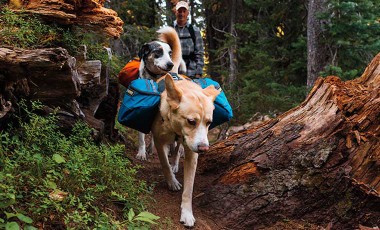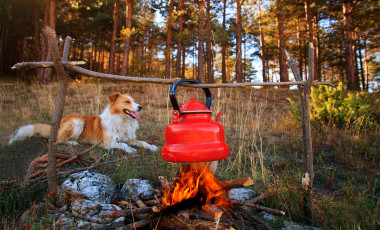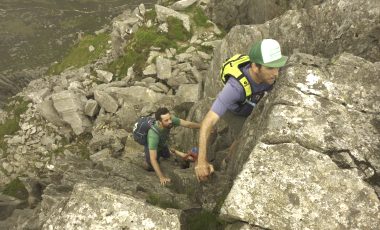Hiking and backpacking with dogs can add a whole new dimension to your time in the wilderness. Dogs have such a wonderful knack of being endlessly positive and energetic. Their presence, when you’re tackling a tough section of trail, can be a real boost to your morale. Taking your dog backpacking is also a great option if you love camping but know that camping with your dog on a regular campsite just won’t work for your puppy. Some dogs totally relish the challenge of getting back to their wild roots and running riot for days on end in the middle of nowhere. But not all dogs will take to it so kindly.
- Infographic: Backpacking with your dog
- Is your dog suitable for backpacking?
- Pros and cons of backpacking with your dog
- Does your dog need a leash?
- Training your dog for backpacking
- How to choose a dog friendly backpacking trail
- Preparing for hiking or backpacking with your dog
- Food for hiking and backpacking with dog
- Dog backpacking gear
- First aid for your dog
- Leave no trace
Disclaimer: We use affiliate links and may receive a small commission on purchases.

Share this Image On Your Site
Is your dog suitable for backpacking?
Before you go setting off on a 10 day trek with your darling Dachshund, it’s important to be realistic about your dog.
What type of dog do you have?
Some dogs are simply not suited to hiking. Consider British Bulldogs, Pugs and Chihuahuas – they might manage a hour or so around the park at their own pace, but from a physiological point of view they just won’t be able to deal with anything more than that. Some of the best breeds of dogs for hiking and backpacking include Border Collies, Golden Retrievers and German Shepherds, but there are also many other dog breeds that absolutely love hiking and backpacking.
If you want to get out backpacking with your dog, your puppy pal should ideally be:
- Strong
- Energetic
- Obedient
- Easily trainable
- Agile
- Non-aggressive
How old is your dog?
Dogs that are less than a year old will still be growing. They’ll need to just stick with short hikes that don’t put any unnecessary stress on their developing bones and joints. Some dogs need to wait even longer than a year before they can start doing serious hiking, so make sure you check with your vet before you start lengthening your walks.
Equally,if your dog is getting on a bit, don’t push the miles. Look out for signs of tiredness and monitor it on each hike. If your old pup is getting tired more quickly than usual then it may just be that it’s ready for something shorter and more chilled out!
Will your dog run off if it catches the scent of a wild animal?
If so, then you need to be sure that he’ll return on your whistle or command. Otherwise you’ll need to keep him on a leash the whole time. For more thoughts on leashing your dog while backpacking and hiking continue to the section on dog leashing.
Is your dog OK on a leash?
Although it would be nice for your dog to roam free for the duration of your time in the wild, there will be times when being leashed is absolutely essential. If your dog isn’t so great with a leash then you’ll need to put some training hours in to get him accustomed to it before you head out into the wilderness.
The benefits of backpacking with dogs
If you’re confident that Fido is the backpacking dog of your dreams, then you’re in for a wonderful time out in the wild, with loads of benefits to having a canine companion at your side.
1Good company
Whether you’re hiking solo or in a group, having your dog with you can be the perfect way to keep you distracted when the going gets tough. And someone to moan at who won’t complain back at you!
2Safety
If you enjoy the solitude of hiking solo but want to feel a little more secure out on your own, then having your best friend at your side will bring you a load of confidence to get out there and explore more. If you have a well trained dog then he also may be your lifeline if something were to go awry.
3They keep you warm at night
If you’re camping in chilly conditions, then your hairy hound will want some warmth from you as much as you will from him. So embrace the dog breath and enjoy the extra cosiness that comes with it.
4They are always entertaining
There’s a reason why so many humans seek the companionship of dogs — they’re just so funny! And having an extra source of entertainment for days out on the trail is always welcome.
The downsides of backpacking with dogs
But there are also a few negatives to taking your dog backpacking and hiking. No matter how much you love your puppy pal, there are times when having him around doesn’t always make sense.
1You have to carry extra stuff
Some dogs will be able to carry their own food and water in a doggie backpack, but others aren’t strong enough to do this, or they simply don’t like it. So either you have to carry an extra heavy pack, or forego taking those few extra layers you need for yourself. Neither option is ideal.
2You can’t ask them their opinion on things!
When big decisions need to be made out in the wild, like should I eat this berry, or should we go North or South, your dog won’t be able to help you out. If you’ve managed to train your dog on these essential communication skills then please tell us how!
3You can’t hike everywhere with your pup
Some trails restrict access to dogs during certain times of the year due to breeding or nesting wildlife etc. And many national parks don’t allow dogs in at all. But there are plenty of dog friendly backpacking trails, so just make sure you check before you go to avoid disappointment.
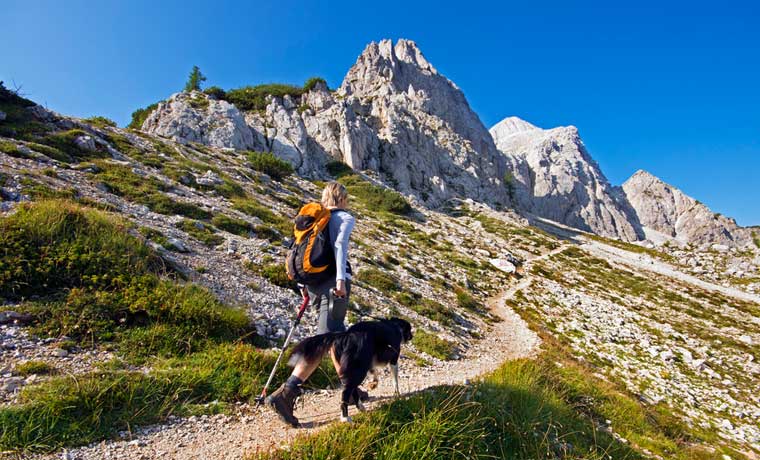
Does your dog need a leash for backpacking?
The use of leashes when backpacking with dogs is always a tricky subject. Some people keep their dogs leashed the whole time, whilst others wouldn’t dream of it and let their hound run wild and free. Before you go dismissing one method or the other it’s worth considering the following and using your best judgement as to how much you use a leash.
Are dog leashes required on the trail you are hiking?
Some trails enforce the use of leashes for various reasons. It may be that the trail is popular with families with children, who may feel threatened by an unleashed dog. Or the rule might be in place to protect unleashed dogs from running into dangerous wildlife or high risk terrain.
Does your dog bound up to people and children to say hi?
No matter how playful and friendly the intentions of your dog may be, it can be really terrifying for small children to have a dog in their face, uninvited. Some people are totally fine with this but some are not, and you just never know.
How does your dog behave around other dogs?
Even if your pup is the perfect angel, you never know how other dogs will react to him, especially if one dog is leashed and the other isn’t. Will your dog just back away if things get aggressive, or will he fight back?
Does your dog stay at your side the whole time?
Some dogs have zero interest in other dogs or other people and are totally happy trotting as close to you as possible. If this is the case, then they will probably be just fine without a leash. But having one at the ready, just in case, is always advisable.
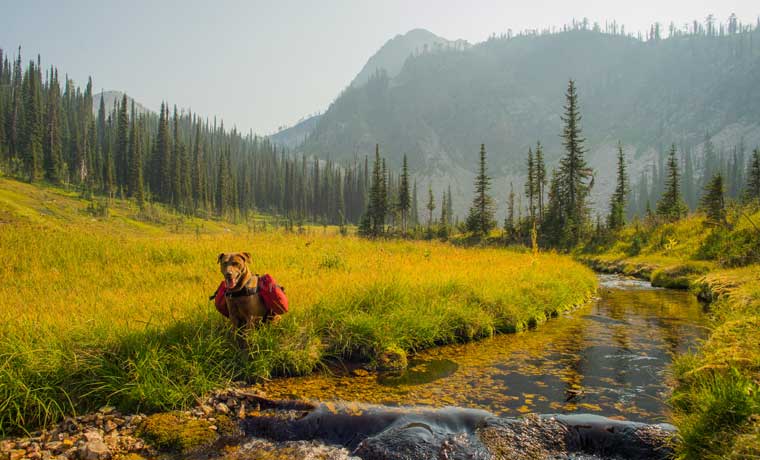
Training your dog for backpacking
Just like us humans, our doggie friends need to build up to long distance hiking trips too, especially if they are not used to them. Before you start a doggie backpacking bootcamp, be sure that your dog is fully grown and ready to start upping the exercise levels. If you are at all unsure of this then ask your vet.
Once you’ve got the go ahead, training your dog for backpacking should include the following:
Endurance training
Start off hiking with your hound on short day hikes. Over the course of a few weeks, increase the difficulty of the hike, and then the distance. Be sure to monitor their progress and once you’re happy that they can deal with the real thing head out on an overnight trip. This will also be good to get your pooch into the habit of keeping you warm at night!
It’s not just their general fitness that you’ll need to work on. Their paw pads will also need to toughen up to deal with the rough terrain that you will tackle along the way. If your dog is just used to stomping on soft grass in the park then as with fitness training, you’ll need to introduce varied and rough terrain slowly.
Agility exercises
If you are planning on hiking in tough and steep terrain it’s a good idea to get your dog used to rock hopping and clambering in a more controlled environment. Set up some obstacles in your back yard that challenge balance and strength as well as agility. This will also help with reinforcing verbal commands that you’ll ideally already be good at as a team.
Water acclimatisation
You may encounter river crossings when backpacking, so your pup will need to be comfortable in cold water and not scared or put off by running water. Start by getting them to paddle in slow running streams and shallow creeks. If they take to it then encourage them into deeper water where they’ll get to experience the cold. Most dogs absolutely love being in the water, but it’s key that you make sure they are comfortable in it before you encounter colder, faster water that you have no choice but to get into.
Dog pack carrying
For long distance trips your dog will need to carry his own food and water (at least), so it’s super important that you slowly acclimatise him to wearing a dog pack and carrying weight in it. Start by just putting it on around the house with no weight in. Once your dog is comfortable in it you can start slowing adding weight to it on walks.
Most dogs should be able to carry up to 25% of their own body weight. But this very much depends on the dog, so it is worth consulting your vet if you are unsure. It also depends on how long you and your dog are hiking for. Some dogs will have no problems carrying that much for a couple of hours but may start to struggle on longer hikes. If you build up the carry weight and walking distance slowly you’ll be able to gauge how your pup is coping and where their carrying limit is.
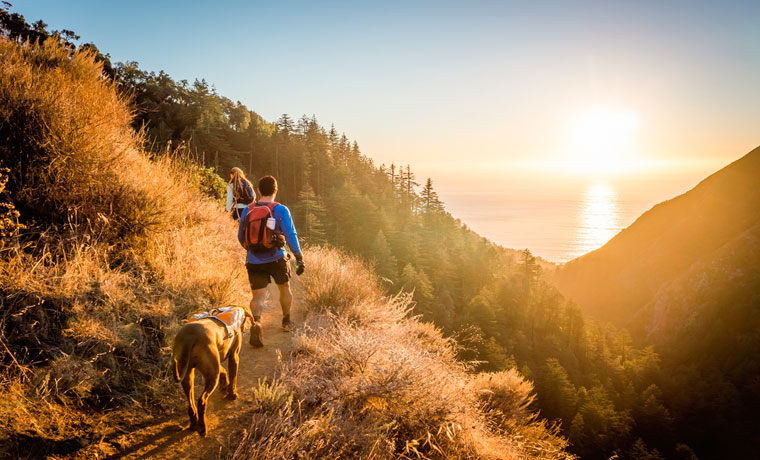
How to choose a dog friendly backpacking trail
Before you head out hiking with your hound on any old trail, it’s super important that you make sure dogs are permitted. As mentioned, there may be seasonal restrictions or dogs may not be allowed in certain areas at all, so look for dog friendly backpacking trails. Once you’re sure Fido is fine to get trekking with you, the next thing you need to consider is what sort of things might you encounter on your chosen trail. Is the trail dog friendly?
Take the time to do some research about your hike so that you know what to expect and prepare for before you embark upon your adventure.
Consider the following when searching for dog friendly backpacking trails:
Is there shade?
If you’re hiking at hot times of the year choosing a hike that has sections of shade will make your pups time in the wild much more enjoyable, and safe.
Are there water sources on your hike?
This is especially important on multi-day trips to keep you hydrated as well as your dog. Otherwise you’ll have to carry whatever extra water your dog can’t carry!
Is the water safe to drink?
Just as we wouldn’t drink unpurified or unfiltered water out in the wild, nor should your dog. Where possible you should filter water from streams and lakes before your dog gets gulping. This is no problem if you have your dog leashed constantly. But if you don’t have them leashed it’s very difficult to monitor where they are drinking from. So find out what parasites and bugs are likely to be in the water where you are hiking. It may be that it’s too risky and another route or area should be considered.
Are there bears, snakes and other predators roaming the area?
If you want your dog to roam free then be sure to opt for areas where an encounter with a wild animal is highly unlikely. And if you’re hoping for real wilderness experience then encounters with wild animals should be expected — so keep your hound leashed. A little bit of research will help you create a clear picture of which species are likely to be hanging around, and which are not.
When will you be hiking?
If you’re planning on hiking during peak times and national holidays, some trails will be much busier than usual. Hiking with a dog on busy trails has the potential to slow you down hugely, especially if you have a cute pup that will get a lot of attention! And you’ll have to keep your dog on a leash the whole time.
Is there likely to be livestock in the area?
This is a really important one to research, as many farmers and landowners won’t think twice about taking action against a dog that is pestering or appearing to threaten their livestock. Many areas will be clearly signed but there may be sections of the hike where you stumble upon grazing herds unexpectedly. In this instance having an excellent call-back is key. But better still, go into the hike expecting them and you can keep your dog leashed.
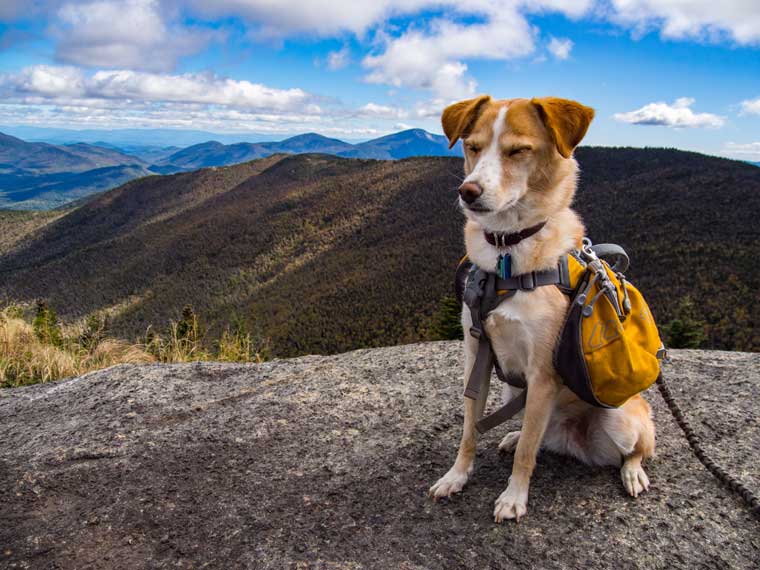
Preparing for hiking or backpacking with your dog
Just as we humans wouldn’t just go on a hike for days on end without preparing for it, so it is with our canine compadres. Aside from the physical training and dog backpacking gear they will need, there are also a bunch of other important things you must do to make sure your pup is fully prepared for hiking and backpacking.
01Camp in your backyard
If your dog isn’t accustomed to sharing a tent with you then either get out on some car camping trips at local campgrounds or do a practice run and camp overnight in your backyard. As well as getting Fido comfortable with the nighttime noises and the enclosed space of your tent, it’ll also help you gauge what your dog will needs in terms of warmth and comfort.
02Get your dog chipped
If you’ve not got your dog chipped already then you might want to consider it if you’re heading out into wilderness areas. If nothing else it will put your mind at ease somewhat if he were to go astray.
03Tag your dog
Be sure that you securely attach an ID tag to your dogs harness or collar. It should have clear and up to date information on. You may also want to consider attaching a capsule to the tag too. You can insert information about your route and contact details etc.
04Get your dog vaccinated
This largely depends on where you are hiking and what vaccinations your dog has already had. Once you’ve decided on the area check with your vet to make sure your dog is covered and up to date on its vaccines — just to be on the safe side.
05Clip claws
If your hound is the sort to come snuggle with you at night then a sharp set of claws clambering onto your sleeping pad will not go down well (although the pad probably will!). Getting claws clipped will also protect the floor of your tent, and will be much more comfortable for your dog if your are hiking on rocky terrain.
06Brush their coat
What before you head out into the wild? Yep! It’s really important that the coat of your dog is free from bugs and fleas that aren’t indigenous to the area you are entering. This also goes for seeds and grasses that might be caught up in your dogs coat.
Food for hiking and backpacking with dog
Just as figuring out your own nutritional needs when hiking can take a bit of trial and error, so it is with your dog’s diet. There’s no right on wrong answer when it comes to correct nutrition for your dog out on the trail. No-one knows your dog’s dietary needs like you do. But if you and your pup are new to long distance hiking then you’ll need a little direction on how much food to pack for your pup, and what sort of food is best.
Dog food for hiking should ideally be:
- Lightweight
- Packable in a container
- High calorie
- Easily digestible
- Not messy
- Delicious!
Here are a few things to consider when packing dog food and treats for day hikes and multi-day backpacking trips:
Dog food type
Being out on the trail is not the time to try out new recipes and food combinations for your dog. That said, the type of food you usually feed your pup may not be totally suitable for carrying on the trail, or it may not provide adequate nutrition from a calorific point of view.
If you are planning a long distance trek with your dog and need to change up his diet, be sure to transition over to the new menu a good few weeks before you head off.
Opting for dried food that is high in meat proteins, fats and vegetables will provide higher calorie content per ounce than food that has a high cereal and grain content. And it’ll also provide better overall nutrition from a health point of view.

The Honest Kitchen dehydrated dog food
This is superbly nutritions option for lightweight trail meals for your dog. Grain-free and packed full of meat, vegetables, vitamins and minerals. All you need to do is add water. Bingo!

TurboPUP Complete K9 Meal Bar
Another really easy (and healthy) option for getting good quality calories on board. Each 4.4oz pack contains 500 calories of human-grade, grain-free goodness.
Volume
Every dog has different needs when it comes to how much food they will need when hiking, and it can be tricky to get right straight away. How many calories your dog will need will vary depending on:
- How long the hike is
- The terrain
- The temperature
- The size of your dog
- Whether your dog is leashed or not
- How much your dog runs
And this is made even harder to judge if your dog is always on the lookout for food even when he’s not hungry!
Try out a few tough day hikes where you increase the volume of food by around 25-30% and see how your hound responds. Then try a two day hike on this amount (with backup food) and re-evaluate. Two days in a row of tough hiking will have a cumulative effect on your dog’s energy levels and depending on how he gets on, you may need to increase the volume by 50 or even 100%.
Dog treats
I’ve yet to meet a hiker who doesn’t constantly nibble on trail mix or snack bars as they hike. And that’s on top of mealtimes. So be sure to have some really yummy, nutritious and energy-filled dog treats at the ready to keep a spring in the step of your bounding hound.
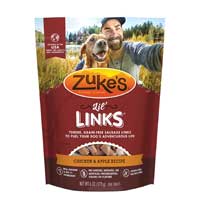
Zuke’s Lil’ Links Dog Treats
Filled with all natural ingredients, a 6oz pack of these meaty treats will give your pooch around 550 calories (19.3 calories per treat). They are grain-free and available in lots of delicious flavours!

Hill’s Science Diet Jerky
Jerky makes for a highly convenient trail snack. It’s protein packed and this particular jerky is also free from artificial colourings, preservatives and flavourings. So delicious your doggie won’t be the only one drooling over the next snack break!

Dog backpacking gear
Once you’ve got the endurance levels of your pup up to a good level and you’re both ready for a multi-day backpacking trip, all that you need to do is make sure you have the right dog backpacking gear.
The best leash for hiking with your dog
The type of leash you use for hiking and backpacking with dogs largely depends on your preference, and what works best for your dog. There are a few types to choose from:

Extendable leash
These are great to give your pup a little bit of freedom whilst being on the leash. But they are not as strong as rope leashes and are cumbersome to carry when not in use.
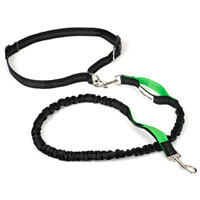
Hands free leash
Connecting a leash to a waist harness is ideal for hiking. Choose one with clips at both ends and you can connect it to your backpack waist belt instead of a separate belt.

Rope leash
Rope leashes are really robust for the rough and tumble of the backcountry, and good to keep your dog close to you and in total control.
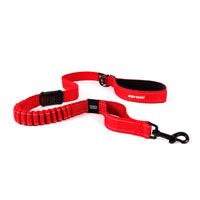
Shock absorber leash
Having a little give in a leash is good for dogs who tend to pull without much notice. It will be less of an impact on them as well as your shoulder socket!
Dog pack
As mentioned, carrying food and water for your hound on top of all your own gear is less than ideal. And if at all possible, you’ll need to get Fido to pull his weight too.
A good dog pack for backpacking should:
- Fit snugly, but not tightly
- Have good padding for comfort when carrying a load
- Have easy access pockets and compartments
- Distribute weight evenly on both sides of the pack
- Have a handle on top to lift or hold your dog easily
- Have a clip to attach a leash
- Ideally be waterproof, especially in rainy or snowy conditions
- Ideally have some reflectors for hiking in low light or when visibility is limited

Ruffwear dog pack
Ruffwear are renowned for their excellent quality and well designed dog packs and backpacking gear for dogs. It is always worth trying a couple of dog packs if possible, but this Approach Full-day Hiking Pack is available in 5 different sizes to suit your pup. It is designed for long day hikes in the backcountry, but will also hold enough for short multi-day backpacking trips.

Mountainsmith K-9 Dog Pack
Available in small (14 litres), medium (24 litres) and large (32 litres) this K-9 Dog Pack is the most “dogonomically” correct backpack design that Mountainsmith has ever created. It has a fully adjustable and padded harness, plus an all important carry handle.
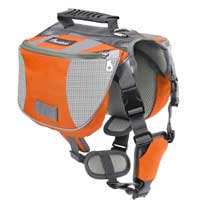
Pawaboo Dog Backpack
This great value Pawaboo dog pack is ideal for those looking to keep costs down. It is a durable and full featured option that has expandable pockets for extra storage. This pack is fully adjustable with a leash attachment point and carry handle.
Dog hiking boots
If you are hiking in cold weather, or your pup’s paws are susceptible to cuts and grazes, doggie booties will really help to keep him going for longer. He’ll probably hate them to start with, so make sure you trial them on short trips first. It may be that you just take the booties with you to use as and when they are needed – that extra bit of protection at the end of a long day will be a big relief for your pooch’s paw pads.

Ruffwear booties
With Vibram soles these Ruffwear Grip Trex All-Terrain Paw Wear for dogs ensures maximum protection for your pup’s paws on rough terrain. The uppers are made from a breathable mesh to minimise discomfort and a restrictive feel.

My Busy Dog Water Resistant Dog Shoes
Available in 8 different sizes, this 4 pack of water resistant dog booties is ideal when hiking with your pup in cold and wet conditions. They have fully waterproof soles that are super grippy and hard-wearing.
Other dog backpacking gear
Your hiking doggie will also need a few other things to help every minute in the wild be the best minute of your pups life! Keep Fido comfortable, safe and warm and you’ll be in for a wonderful trip.

Musher’s Secret Pet Paw Protection Wax
This wax based cream is ideal for dogs who don’t take to wearing booties. Apply it just before heading out and it helps protect your pups paw pads from abrasive and rough surfaces and cold snowy trails. It is also highly effective at treating cracked and dried paws.

Cooling vest
If you are hiking in hot climates and you need to keep down the body temperature of your pup, soaking a cooling vest in cold water can significantly help. The outer layer reflects the hot rays of the sun away while evaporative cooling inside the vest mimics the cooling effect of humans’ sweat.
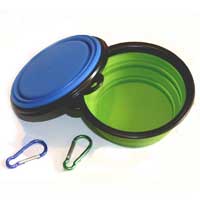
Collapsible bowl
These are quick and easy to use and can be clipped onto the outside of your own backpack without adding much extra weight at all.

Collapsible water bottles
Collapsible water bottles are ideal for spreading the weight of water that your pooch has to carry in his pack. Plus, once the bottles are empty they’re much lighter and more compact than regular bottles keeping Fido light on his toes as he tires.

Waterproof jacket
For long hikes in cold and wet weather you may need to consider a jacket for your pup — especially if it has short hair. There are all sorts available, but this one is non-insulated but waterproof.

Sleeping mat
In cooler conditions your dog will need some insulation beneath him — just like you! Cut a closed cell sleeping pad in half or use a foam sitting pad — lightweight, insulating and highly durable. In really cold conditions you may also want to consider a blanket. Or just get your pup to cuddle up to you for warmth!

Lightweight towel
You have the advantage of taking off your boots before you get into the tent, but unless you pup is wearing booties you’ll need to get him cleaned up. It’s worth carrying a small microfiber towel to get Fido clean and dry before he shakes all over your dry gear!

Harness
If you’re hound is hiking without a pack then you may want to consider using a harness instead of collar. Some dogs find them more comfortable preventing excess pressure on their necks. And a harness makes lifting your dog much easier. Check out the best options in our dog harnesses article.
Leave no trace
It would be easy to think that the Leave No Trace Principles don’t apply to animals. But they absolutely do. And if you are in charge of an animal in the wild then some of the principles apply even more.
The main things to remember when hiking and backpacking with dogs are:
Poop disposal
On day hikes dog poop should be carried out. Double bag if you have to! And on multi-day trips, poop disposal should be treated as if it were human waste — bury it in a deep hole away from water sources and trails.
Respect wildlife
Keeping your dog on the trail is the easiest way to respect the wildlife you are hiking with and through. And even if you know your pup just ain’t fast enough to catch that scampering rabbit, it doesn’t make it OK to frighten the living bajingles out of it just for a giggle.
Be considerate of other visitors
Remember than not all hikers and trail users love dogs as much as you do. And some are actually very scared of dogs. So be sure to keep control of your hairy hound and always yield to passing foot traffic.
For a quick reminder of the principles take our LNT quiz. As you do it try to apply every question to your dog too.
First aid for your dog
Having some basic knowledge of doggie first aid is a must if you plan on heading out into the backcountry. Their natural curiosity and endless stoke for fresh things to smell and new places to explore can lead them into some pickles that their doggie brains aren’t able to anticipate. Make sure you pack a dog specific first aid kit, but the best course of action is to try and prevent things from going awry in the first place.
Keeping control of your dog will help prevent potential mishaps like running into dangerous wildlife or having confrontations with other dogs.
Check for ticks at the end of every day. To minimise the chances of the tick transmitting diseases to your dog, they need to be removed within 24 hours of them latching onto your pup. Tick keys make extracting them really quick and easy.
Make sure your dog drinks plenty of water. It’s really easy to miss the signs of dehydration as they will most likely be panting the whole time anyway. So get into the habit of giving your dog water whenever you have water. If you are hiking a long way then it’s essential that the hike you choose has plenty of running water that you can filter, as carrying enough for both of your will be far too heavy.
It’s important to know when to stop. Over time you will learn to read the signs that your dog is giving you to tell you that he needs a break. But if you’re not sure then keep an eye out for the following:
- Slowed pace
- Lying down
- Tail down or tucked under
- Licking of paws
Some dogs just don’t know when to stop and will keep going forever, regardless of how shattered they are. This might be OK for a day hike as they can chill out the day after. But on multi-day trips you need to help your dog pace himself.
Taking your dog hiking and backpacking is such a great way to let your dog just be a dog. And so long as you are prepared and use the trail with respect, then everyone else will love your darling doggie being there as much as he will.


